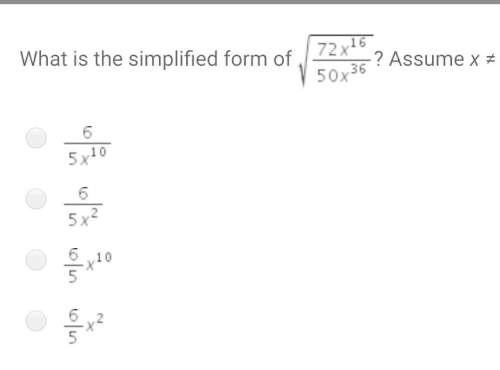
Mathematics, 20.08.2020 01:01 burgoonp
The graph represents the heights of two climbers on a climbing wall over a 12-minute time period. A graph titled The Climbing Wall where the horizontal axis shows time (minutes), numbered 1 to 12, and the vertical axis shows height (feet) numbered 2 to 24. The line labeled Brynn's climb begins at 0 feet in 0 minutes, to 15 feet from 5 to 7 minutes, to 0 feet in 10 minutes. The line labeled Abby's climb begins at 4 feet in 0 minutes, to 14 feet from 4 to 6 minutes, to 22 feet in 8 minutes, to 0 feet in 12 minutes. Which statement is true about the climbers’ heights? Brynn was resting at a constant climbing height when Abby’s climbing height was decreasing. Abby’s climbing height was decreasing when Brynn’s climbing height was increasing. The heights of both climbers increased, then decreased, with no rest at a constant height. Both climbers rested on the wall at a constant height for 2 minutes.

Answers: 1


Another question on Mathematics

Mathematics, 21.06.2019 17:20
Which functions shave a maximum and are transformed to the left and down of the parent function ,check all that apply f(x) = x2? p(x) =14 (x+7)2 + 1
Answers: 3

Mathematics, 21.06.2019 20:00
Consider the set of all four-digit positive integers less than 2000 whose digits have a sum of 24. what is the median of this set of integers?
Answers: 1

Mathematics, 21.06.2019 21:30
In a test for esp (extrasensory perception), the experimenter looks at cards that are hidden from the subject. each card contains either a star, a circle, a wave, a cross or a square.(five shapes) as the experimenter looks at each of 20 cards in turn, the subject names the shape on the card. when the esp study described above discovers a subject whose performance appears to be better than guessing, the study continues at greater length. the experimenter looks at many cards bearing one of five shapes (star, square, circle, wave, and cross) in an order determined by random numbers. the subject cannot see the experimenter as he looks at each card in turn, in order to avoid any possible nonverbal clues. the answers of a subject who does not have esp should be independent observations, each with probability 1/5 of success. we record 1000 attempts. which of the following assumptions must be met in order to solve this problem? it's reasonable to assume normality 0.8(1000), 0.2(1000)%30 approximately normal 0.8(1000), 0.2(1000)% 10 approximately normal srs it is reasonable to assume the total number of cards is over 10,000 it is reasonable to assume the total number of cards is over 1000
Answers: 1

You know the right answer?
The graph represents the heights of two climbers on a climbing wall over a 12-minute time period. A...
Questions






Mathematics, 30.11.2020 06:40

Mathematics, 30.11.2020 06:40

Mathematics, 30.11.2020 06:40


English, 30.11.2020 06:40


Mathematics, 30.11.2020 06:40

Business, 30.11.2020 06:40


History, 30.11.2020 06:40

English, 30.11.2020 06:40

Mathematics, 30.11.2020 06:40

Mathematics, 30.11.2020 06:40

History, 30.11.2020 06:40

Advanced Placement (AP), 30.11.2020 06:40




